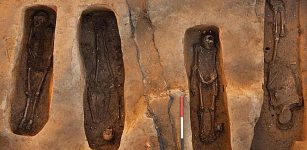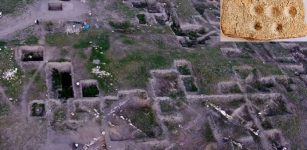Ancient City Of Timgad: Largest Roman Settlement Ever Built In North Africa
A. Sutherland - AncientPages.com - The great ancient city of Timgad is the largest Roman settlement ever built in North Africa.
In AD 100, Emperor Trajan created the city on the northern slopes of the Aures Massif, approximately 170 km south of the Mediterranean coast.
Arch of Trajan in Timgad. Image credit: alioueche mokhtar - CC BY-SA 4.0
The city's ancient name was Thamugadi. Its still impressive ruins are located at the intersection of six roads, it served as a Roman military garrison town, and its plan, laid out with great precision, illustrates the skills of Roman urban planners. The outpost, established on a perfectly square grid, had to control one of the passes through the Aures Mountains to the Sahara.
The town soon outgrew its original plan, and additional structures were added outside the grid. Timgad - inhabited mainly by Roman veterans - was a peaceful town for several hundred years.
From the 3rd century, it became a center of Christian activity. The city was walled but not fortified. Initially designed for around 15,000, the city quickly outgrew its original specifications and spilled beyond the orthogonal grid in a more loosely organized fashion.
Buildings constructed entirely of stone were frequently restored during the Empire's time. In Timgad, only Roman citizens could live comfortable lives. However, the Romans knew they had to do much more in the area and not only for the Empire's citizens.
Timgad - Current situation at the excavation site. Image credit: Zenstar - CC BY-SA 4.0
The locals' resistance was strong, but the Romans managed to cope with the troublesome tribes by attracting these people to Timgad's buildings built entirely of stone, and the town had a much better social life than the surroundings.
They also offered suitable places to develop the commerce of local products. Soon, many natives joined the Roman Legion for a 25-year term to obtain Roman citizenship for themselves and their sons.
Pax Romana, a 200-Year-Long Period Of Stability within the Roman Empire, helped Timgad to become an attractive settlement. In just 50 years after Timgad's foundation, indigenous people mainly inhabited the city.
Timgad Was A Strong And Thriving Colony
The city's rapid growth occurred by the middle of the 2nd century. In several quarters, there were many temples, markets, baths, and Capitolium.
Timgad . Detail of the arch, east side with niche architecture. Image credit: Bachounda - CC BY-SA 3.0
Most of these buildings date from the Severan period (193 and 235 AD); it was a prosperous time when the city enjoyed its Golden Age, also attested by immense private residences.
Buildings constructed entirely of stone were frequently restored during the Empire: the Trajan Arch in the middle of the 2nd century, the Eastern gate in 146, and the Western gate under Emperor Marcus-Aurelius.
Timgad's underground reservoir collected water for the bathhouses, pools, and fountains, and there was also modern drainage, sewage system, and luxuries such as lavatories that could be heated during winter.
Timgad's theatre, a library, and a forum delivered many entertainments. People enjoyed fountains and bathhouses with walls and floors decorated with beautiful mosaics displaying pagan mythological scenes. Today, the city's marketplace, the so-called Timgadu Bazaar with benches and stone tables, is considered much better preserved than in other Roman cities.
Timgad Arch And Library With 3,000 Scrolls
One of the impressive ancient structures was the triumphal arch. The Arch of Trajan ( partially restored in 1900), also known as the Timgad Arch, was built with three arches and mainly of sandstone.
It remains unknown when the Library at Timgad was built, but it is known that it was a gift to the Roman people by Julius Quintianus Flavius Rogatianus.
Timgad - ruins. Three-quarter view of the west side. Image credit: Zinou2go - CC BY-SA 3.0
The library is a one-story building with niches for scrolls and cabinets containing a book warehouse. Initially, it occupied a rectangular area (eighty-one feet (24.69 meters long by seventy-seven feet (23.47 meters) wide. Once, it was a fully developed library system indicating the people's high standard of learning and culture. It is believed that it could have stored 3,000 scrolls.
In the city, the ruins of a huge amphitheater, sixty meters in diameter and able to accommodate 4,000 spectators, have been preserved.
The Destruction Of Timgad
Timgad was a celebrated bishopric during the Christian period, but the Vandal invasion of the fifth century destroyed the city's prosperity. Finally, the Arab invasion left Timgad totally destroyed. After the 8th century, the city ceased to be inhabited.
Written by – A. Sutherland - AncientPages.com Senior Staff Writer
Updated on November 16, 2023
Copyright © AncientPages.com All rights reserved. This material may not be published, broadcast, rewritten or redistributed in whole or part without the express written permission of AncientPages.com
Expand for referencesMore From Ancient Pages
-
 Ancient Mystery In The Alpes Remains Unsolved Because Of Contradicting Information
Ancient Mysteries | May 15, 2018
Ancient Mystery In The Alpes Remains Unsolved Because Of Contradicting Information
Ancient Mysteries | May 15, 2018 -
 Rare Gladiator Tombs Found In Ancient City Of Anavarza In Southern Turkey
Archaeology | Aug 16, 2022
Rare Gladiator Tombs Found In Ancient City Of Anavarza In Southern Turkey
Archaeology | Aug 16, 2022 -
 Crannogs – Artificial Islands In Scotland Are Older Than Stonehenge
Archaeology | Jun 17, 2019
Crannogs – Artificial Islands In Scotland Are Older Than Stonehenge
Archaeology | Jun 17, 2019 -
 Surprising Discovery Of Ancient Roman Salt Factory In England
Archaeology | Oct 8, 2020
Surprising Discovery Of Ancient Roman Salt Factory In England
Archaeology | Oct 8, 2020 -
 Secrets Of Mona’s Caves: Rock Art Reveals Ancient People Were Ahead Of Their Time Long Before The Arrival Of Columbus
Archaeology | Nov 4, 2017
Secrets Of Mona’s Caves: Rock Art Reveals Ancient People Were Ahead Of Their Time Long Before The Arrival Of Columbus
Archaeology | Nov 4, 2017 -
 Study: Paleo-Americans Hunted Mastodons, Mammoths And Other Megafauna In Eastern North America 13,000 Years Ago
Archaeology | Jun 15, 2023
Study: Paleo-Americans Hunted Mastodons, Mammoths And Other Megafauna In Eastern North America 13,000 Years Ago
Archaeology | Jun 15, 2023 -
 Jamestown: Unearthed graves with four bodies and a small sealed silver box
News | Aug 28, 2015
Jamestown: Unearthed graves with four bodies and a small sealed silver box
News | Aug 28, 2015 -
 Unexplained Mystery Of The Untraceable Stone-Throwers – Strangeness In North America, Belgium And Indonesia – Part 1
Featured Stories | Nov 11, 2019
Unexplained Mystery Of The Untraceable Stone-Throwers – Strangeness In North America, Belgium And Indonesia – Part 1
Featured Stories | Nov 11, 2019 -
 Remains Of An Ancient Seaport In Asini, Greece Discovered By Underwater Archaeologists
Archaeology | Mar 12, 2025
Remains Of An Ancient Seaport In Asini, Greece Discovered By Underwater Archaeologists
Archaeology | Mar 12, 2025 -
 10 Great Ancient Mysteries Of Africa
Civilizations | Mar 12, 2017
10 Great Ancient Mysteries Of Africa
Civilizations | Mar 12, 2017 -
 Oxford University Is Older Than The Aztec Empire – Historical Records Say
Ancient History Facts | Dec 5, 2017
Oxford University Is Older Than The Aztec Empire – Historical Records Say
Ancient History Facts | Dec 5, 2017 -
 Bona Sforza – Ambitious Queen Of Poland Was Betrayed And Murdered
Featured Stories | Jan 21, 2019
Bona Sforza – Ambitious Queen Of Poland Was Betrayed And Murdered
Featured Stories | Jan 21, 2019 -
 Will The Oven Bricks Of The Tudor Warship The Mary Rose Be Preserved Before It’s Too Late?
Artifacts | Apr 7, 2022
Will The Oven Bricks Of The Tudor Warship The Mary Rose Be Preserved Before It’s Too Late?
Artifacts | Apr 7, 2022 -
 Voice Belonging To 3,000-Year-Old Egyptian Mummified Priest – Recreated
Archaeology | Jan 28, 2020
Voice Belonging To 3,000-Year-Old Egyptian Mummified Priest – Recreated
Archaeology | Jan 28, 2020 -
 Agora: An Ancient Meeting Place Visited By Many Famous Philosophers
Ancient History Facts | Apr 13, 2016
Agora: An Ancient Meeting Place Visited By Many Famous Philosophers
Ancient History Facts | Apr 13, 2016 -
 Oldest Sea Reptile From Age Of Dinosaurs Found On A Remote Arctic Island
News | Apr 3, 2023
Oldest Sea Reptile From Age Of Dinosaurs Found On A Remote Arctic Island
News | Apr 3, 2023 -
 5,000-Year-Old Stone Paint Palette Unearthed In Küllüoba Mound
Archaeology | Sep 9, 2020
5,000-Year-Old Stone Paint Palette Unearthed In Küllüoba Mound
Archaeology | Sep 9, 2020 -
 Is There An Over-Looked Ancient Secret In Sahara?- Intriguing Theory Examined
Ancient Mysteries | Jul 30, 2019
Is There An Over-Looked Ancient Secret In Sahara?- Intriguing Theory Examined
Ancient Mysteries | Jul 30, 2019 -
 Mysterious Mount Kailash: Secrets Of The Man-Made Pyramid And Entrance To The City Of The Gods
Ancient Mysteries | Oct 27, 2014
Mysterious Mount Kailash: Secrets Of The Man-Made Pyramid And Entrance To The City Of The Gods
Ancient Mysteries | Oct 27, 2014 -
 Fascinating Time Capsule With Secret Code Found In North Carolina
Featured Stories | Jun 6, 2024
Fascinating Time Capsule With Secret Code Found In North Carolina
Featured Stories | Jun 6, 2024




